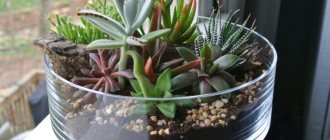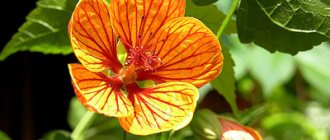Home » Flowers and plants » Indoor plants
Svetlana Shevtsova 03/17/2020
3264 Views
Ficus elastica (Ficus elastica) is a perennial plant from the Mulberry family. Thanks to its wide, glossy foliage, it has gained popularity among gardeners. After all, you can look into it like in a mirror.
The island of Java is considered the homeland of the ficus, where it is revered as a sacred plant. It got its name because the vegetative parts secrete a thick juice containing rubber, which is used industrially for the production of rubber.
Growing rubber ficus at home is not difficult. Thanks to breeding work, many varieties have been developed that differ in size and color of foliage.
Botanical description of the plant
Painted outfit of rubber ficus
In its natural habitat, ficus grows as a tree, sometimes reaching a height of up to 30 m. Thanks to its aerial roots, it also grows in breadth. They descend to the ground and grow into the ground. Through aerial roots, the plant receives a set of necessary nutrients for good development.
The twisting roots of the ficus evoke an association among local residents with a snake. That’s what they call it: “Snake Tree.”
Leathery, elliptical, oval leaves are quite large, leathery, with a good gloss. They are located alternately on the tree.
Young foliage is hidden in stipules, colored red-brown. As the leaves unfold, they dry out and crumble.
In nature, pollination occurs thanks to a certain type of insect. But the process itself is of no value. When growing ficus indoors, there is no flowering, since there is no one to pollinate it, unless you do the cross-pollination yourself.
After flowering, small inedible syconia appear on the tree. The milky sap contained in ficus can cause allergic reactions.
Features of cultivation
There are several recommendations that you should familiarize yourself with before planting a ficus:
- The cutting must be from a mature branch, with at least one growth point.
- Before planting a ficus cutting, you need to be patient. Normally, roots appear in 3-4 weeks. But sometimes this period is extended.
- The time of transplantation and reproduction is a warm season, without sudden temperature changes.
- The young sprout needs to choose a good place - without drafts and direct sunlight. Ideally, you can create a “green corner” on one of the window sills - shade part of the window with paper so that the light becomes soft and diffused.
- The cuttings are sometimes split at the bottom for better rooting. But this can only be done with woody shoots.
- The bush is transplanted to a permanent place only when it has 4 new leaves.
Ficus rubber: common species and varieties
Ficus rubbery
Some indoor varieties are also capable of releasing juice. Let's look at the most common varieties for indoor floriculture, the right choice of which will transform your home.
Ficus Robusta
Photo: Robusta
Ficus Robusta The most popular variety. Robusta has a wide stem and fleshy, leathery leaves that are dark green in color. A notable feature of the variety is that the huge leaves have a downward curved tip.
Ficus has been cultivated for over 100 years. A tall tree will decorate a luxurious hall or living room with its beautiful crown.
Robusta is necessary in the office, as according to natural beliefs, it cleanses negative energy well.
Ficus Tineke
Photo ficus: Tineke
Ficus Tineke (Tineke) Tall tree with large and elegant foliage, reaching 30 cm in length. The plant's homeland is considered to be the Indonesian and Indian subtropics. Can be grown indoors up to 2 m in height.
The highlight of the variety is the color of its leaves: in the middle of each leaf there is a central vein of pink or cream flowers. A thin pistachio or cream border runs along the edge of the leaf blade.
Suitable for growing in an interior created in a minimalist style. A lush crown can be achieved through constant pruning.
When purchasing a variety, you need to know that the variety is beautiful and whimsical at the same time. To maintain variegated foliage, you will need to maintain a certain level of humidity at all times, as variegated varieties require more attention!
Melanie
Melanie
Melany Unlike its counterparts, the Melany variety bred by Dutch breeders is distinguished by its moderate growth, bushes well and has dark foliage color. Compactness and beauty in one plant!
The reddish tint of young foliage gives way to a green tone with age. It is also considered a capricious variety.
Looks beautiful in a small room. Due to the fact that the plant responds well to pruning, you can create a unique specimen by shaping the crown at your discretion.
Black Prince
Black Prince
Black Prince The name speaks for itself. The branches of the variety are almost black in color, as are the foliage.
Found naturally in West Africa and Indonesia. A favorable climate allows the plant to “grow by leaps and bounds.” In nature, it is a tree up to 40 m high.
It is noteworthy that the dark color changes throughout the daylight hours. The ficus takes on a very rich black hue in the evening.
A hall made in ethnic style will be the best place to keep this variety.
The variety has its pros and cons. When grown in a darkened room, ficus grows slowly. This is a minus. A plus is that in summer the plant can be taken out into the garden.
Abidjan
Abidjan
Abidjan Brief description. The Asian tropics are the birthplace of this variety.
The dark overseas guest is an unpretentious plant that adapts to the conditions provided to it. However, it prefers warmth and humidity.
Origin
The rubber plant is native to Southeast Asia. Or rather, the expanses of India, China, Sumatra and Java. The subtropical regions of these countries and islands are best suited for the plant to grow in natural conditions. This tree has been in cultivation since the beginning of the 19th century. It is usually grown in specially selected large flowerpots. The growth of the giant is limited precisely by the dimensions of the container.
In the natural environment, its height can reach 50 meters. With proper environmental humidity, rubber plants are able to develop aerial roots. They spread in all directions.
Home care
Ficus rubber plant care at home
To care for different types and varieties of ficus, there are certain rules that are the same for all representatives of the Mulberry family.
Lighting
Ficus rubbery
Under no circumstances should you place a flower pot in a place where it would be exposed to sunlight. The leaves will suffer. But the lighting should be bright and diffused at the same time.
When grown in a shaded place, the ficus will lose its lower leaves. The tree's growth will instead decrease.
Temperature
Ficus rubbery
The optimal temperature for growing is +20-23° degrees. Winter maintenance should take place at a temperature of +15°C and above.
Proper watering and moisture maintenance
Moderate watering is the key to plant health
Watering should be carried out only after the earthen ball has dried out almost halfway down the pot.
During the period of active growth, water once a week, less often in winter, depending on the circumstances.
Too frequent waterlogging of the soil can lead to leaf fall and the plant will lose its decorative effect.
The plant needs to be sprayed with warm, settled water. From time to time you need to arrange a shower.
You can’t spray in winter; at this time, a dormant period begins, and in order to maintain humidity, you will need to place the container on moistened pebbles or expanded clay, or you can line it with sphagnum moss.
Fertilizer application
Fertilizer for ficus
During the growing season, as soon as the ficus begins to grow, it is necessary to provide it with all useful substances. Fertilizing should be done once every 2 weeks. When it begins to grow, nitrogen should be added to enhance growth.
Feeding should be done alternating mineral fertilizers with liquid organic matter.
Many gardeners, to maintain a glossy shine and preserve decorativeness, polish the ficus elastic leaf with chemicals. This is absolutely impossible to do. To make the leaves shine, you can wipe them with non-alcoholic beer.
Water method
There are several ways to root a ficus. Rooting cuttings in water is the easiest of them. The prepared branches must be placed in boiled water so that it covers the lower growing point. It is better to take a container that is darkened, since blue-green algae quickly appears in the sun, preventing root growth.
Once every 3-4 days, the water needs to be refreshed - change about half the volume with a new one, plus top up to the desired level as it evaporates. It is not worth keeping the ficus in water for a long time. As soon as roots of 2-3 cm appear, the plant can be transplanted into the ground. If you allow the root system to develop too much in the water, then later the bush will have a hard time being moved into the ground.
Transfer rules
Ficus transplant
In the first years after planting, it is recommended to replant plants more often, each time increasing the volume of the pot.
Little tricks:
- You can understand that a ficus needs a transplant by the fact that after watering the water immediately flows into the pan
- The selection of the next pot should be in accordance with the previous dimensions and exceed them by 5 cm
- You should not handle old plants of the ficus genus; you can destroy them by damaging the root system. All that needs to be done is to remove the top layer of soil and fill this space with new substrate
If there is no suitable soil, you can buy a ready-made substrate at a flower shop.
Ficus transplantation: step-by-step instructions
Moving to permanent residence
- Be sure to lay a drainage layer at the bottom of the new pot.
- Fill the pot 1/3 with new soil to which sand has been added, carefully transfer the plant from the old pot to the new one, trying not to damage the root system
- Watering after transplantation should be moderate
If the conditions are met, the ficus elastica will quickly adapt to its new place of residence and begin to grow.
Planting cuttings
To plant a prepared cutting, you will need a mixture of substrate and a container, which does not have to be large, since after the start of the active growth phase it will be possible to transplant the elastica into a more suitable pot.
It is necessary to prepare the following substrate for the successful development of a young plant:
- peat – 1 part;
- sand – 1 part;
- drainage – 1 part;
- leaf soil - 5 parts.
For sterilization, it is also recommended to water this substrate with a solution of potassium permanganate and, after drying, begin planting the plant. The procedure for planting cuttings is standard; you need to make a hole and moisten the soil, loosen it and then place the sprout in the hole made, keeping as close to the center as possible.
Rooted cuttings
Crown formation
Pruning is done using pruning shears
Thanks to pruning, which the flower tolerates well, you can form a neat crown.
Don’t think that cutting off the top will result in a gorgeous bush. After the manipulation, the dormant bud wakes up and the plant grows upward again, only it looks a little twisted.
To get a compact bush, you need to know how to prune a ficus correctly.
They form it like this: you need to cut off the top, going down 5 internodes. The cut cuttings can be rooted.
After the plant reaches a certain height, it will need to be pruned again. The best time is the beginning of spring, when the plant is just starting to grow.
Formation of the crown of rubber ficus
There is one more trick for getting a lush bush: it is recommended to plant several cuttings in one pot.
Some specimens do not want to bush at all. To pacify their temper, flower growers resort to little tricks.
First, they take an awl and pierce the stem 1/3 of the way through. The procedure must be carried out starting from the top, gradually moving down.
Secondly, you will need to tilt the top of the ficus down as much as possible. Not being able to grow upward, the plant gives an impetus to the awakening of the dormant bud, which is located above all. After the new shoot is released, the top is released, and it takes its usual position.
From side shoots
Planting material can also be prepared from lateral semi-lignified long shoots. The branch is cut into 15-20 cm pieces, with 4-5 leaves on each. They are prepared for planting in the same way as the apical ones. But stem cuttings from side shoots take root much more slowly, and some of the planting material dies. If you use growth stimulants – liquid and powder – the result will be better.
Reproduction
Reproduction of rubber ficus by leaves and cuttings
To obtain new specimens, two methods are used: propagation by leaves and cuttings. Some use the method of propagation by layering.
Propagation by leaves with internodes
Planting a leaf cutting
It is easy to propagate ficus with leaf cuttings, the main thing is that it has a piece of internode.
When rooting a ficus leaf without part of the internode, you should not wait for the appearance of a new plant. The leaf will take root, but due to the fact that there will be no growth point on it, the new plant simply will have nowhere to emerge from.
You can plant the leaf in any cup, at the bottom of which you need to lay a layer of drainage and make holes to drain excess water.
Before planting, it is necessary to prepare the soil by mixing it with a baking powder - perlite. If it is not there, you can add sand.
When planting a leaf in the ground, you need to make sure that the bud is not buried inside.
After cutting the leaf, milky juice will be released from below. You can’t plant it right away, as it will interfere with rooting. It needs to be placed on the table and planted only after the cut is dry.
Rooting lasts about a month. You can speed up the appearance of roots by creating greenhouse conditions for the plant.
Cuttings
Cuttings with internodes
If the ficus is overgrown and the stems are bare, it is recommended to renew the plant. This will be facilitated by formative pruning.
As a result, a lot of planting material will appear - freshly cut apical cuttings. The middle parts should not be thrown away; they can also be used for propagation.
For successful rooting it is necessary that:
- the length of the cuttings was not less than 7 cm
- On each cutting you must leave at least 2 internodes with leaves
- the cut should be made directly under the lower bud
After cutting the cuttings, you need to rinse them in running water to wash off the milky juice. A prerequisite is also to twist the lower leaves into a tube and fasten them with an elastic band. In this case, the bottom side should face inward.
Landing is carried out at an angle. The cutting must be lowered into the soil so as to hide 1 internode. After which, water.
Ficus propagation by leaf
You can speed up the appearance of roots by covering the glass with the cutting with polyethylene or film. With lower heating, rooting occurs much faster.
The apical cuttings take root easily in water. Preparing cuttings for this method of propagation is similar to propagation by cuttings.
The water should be boiled and completely cooled. Activated carbon is added for disinfection.
During rooting, it is necessary to monitor the water level in the glass. If you allow even short-term drying out, the root buds will simply die.
When the roots appear, the cuttings are planted in prepared soil and watered. To be more confident, you can keep the cutting under a glass jar for the first few days.
You can root in peat tablets. They contain completely balanced soil with the necessary nutrients. When used correctly, 100% results are guaranteed.
Apical cuttings
In spring, ficus trees are pruned to ensure proper growth. The apical shoots make excellent planting material. But there are a number of conditions:
- Cuttings should not be less than 15 cm, each should have 3-4 full leaves.
- It is better not to use completely green shoots (and they are often found at the top of the bush). The branch has not yet gained the strength to grow and will not be able to take root. It is better to choose semi-lignified shoots.
Before planting ficus cuttings, you need to properly prepare them:
- Cut to the desired length, make an oblique cut at the bottom. The top point of the bottom cut should be as close as possible to the kidney.
- Remove the bottom sheet and cut off half of the rest.
- Place the branches in water. This will prevent the sticky, whitish juice from hardening in the air. Keep for 3-5 hours. At this stage, you can add various phytostimulants such as “Kornevin” and similar drugs.
- Remove from the water and dry the sections for 15-20 minutes. Dust all damaged areas with coal dust. You can also dip the cut in a powdered growth stimulator.
The cuttings are ready. Now they need to be rooted and then transplanted into the ground.
Diseases and pests
Ficus disease
As a result of the activity of insect pests, the plant may develop fungal or infectious diseases. Therefore, before starting to treat the disease, it is necessary to get rid of parasites.
Spider mite
Spider mites, scale insects, thrips, mealybugs are frequent uninvited guests. If you find them, you need to go to a specialized store and buy insecticides for treating plants. When diluting the working solution, you must strictly follow the instructions without exceeding the dosage. Because you can destroy the plant itself.
Shchitovka
Scale insects are considered the most dangerous pest. Settling on a ficus tree, she sucks out all the juices from it. As a result of the vital activity of the parasite, the glossy foliage becomes dull and loses its decorative effect. It becomes covered with a sticky coating and rot begins to appear.
Before spraying, you need to walk over all vegetative parts of the plant with a sponge dipped in laundry soap foam.
It doesn't matter if soap gets into the soil. It will not harm the plant!
Then you need to take a warm shower, let the ficus dry and treat the plant with chemicals.
Spider mites also harm the plant. The infected specimen is stunted and its development stops.
Spider web on ficus
To combat the parasite, you can use Fitoverm, Actellik, Aktaru. After spraying, you need to regularly ventilate the room.
For prevention purposes, it is necessary to prevent dry air in the room and ventilate it frequently. Drafts should not be allowed.
Ficus does not like cold air. Yellowing of foliage may occur
To increase humidity, you need to place the pot on wet pebbles.
To combat mealybugs, industrial preparations are also used if folk remedies do not produce results.
Ficus rubber is medicinal, since on its basis drugs are made to combat diseases such as mastopathy and are used in the prevention of oncology.
The benefits and harms cannot be underestimated, since one must know moderation in everything. The juice helps cure radiculitis and osteochondrosis. However, people suffering from allergies and asthmatics are contraindicated in growing it in an apartment. But in general, believing in signs, ficus brings prosperity to the house! You can learn how to properly care for and propagate ficus from the video below.
VIDEO: Ficus rubber care and reproduction
Ficus rubber care and reproduction
Rubber-bearing ficus at home: species and varieties that grow well in the house, planting and care, rules of propagation and crown formation | (130+ Photos & Videos)
Common mistakes
Before transplanting a ficus (with cuttings, leaves, layering - it doesn’t matter), you need to thoroughly treat all equipment with any antimicrobial agent or pour boiling water over it. This will also help get rid of pest larvae when using a used pot.
Common mistakes that novice gardeners make include:
- Excessive watering. Leads to root rot and plant death.
- Abuse of fertilizers. Sometimes a gardener who carefully cares for his plants has all his bushes wither and wither, while in a stuffy office the ficus feels great. And in this case, it’s most often a matter of banal overfeeding.
- No household humidifier or daily spraying.
- Rooting of an immature leaf - without a stem or bud. Even if the bush grows from such unsuitable material, it will be weak and undeveloped.
Source











